May 23, 2017 – Volume 19 #4: The Dizzying Pace of Renewables
In This Issue
Flanigan’s Eco-Logic
Background on Community Choice Aggregation
The History of CCAs in California
Los Angeles Forms LACCE
The Hawaiian Power Update
The Fortune 500 Nears the Tipping Point
Kentucky Coal Museum
Nuclear Power Quiz: Six Questions
Westinghouse’s Nuclear Bankruptcy
Meatless and Healthy Mondays
Solar Power in the Middle East
Microgrids and PERCs White Paper

Flanigan’s Eco-Logic: The Dizzying Pace of Renewables
It’s not hard to be struck by the dizzying pace of renewable energy. A headline from England: “A Day without Coal!” It was the nation’s first full day without burning coal to make electricity since the Industrial Revolution. According to National Grid, “Friday, the 21st April was the first 24-hour period since the 1880s where Great Britain went without coal-fired power stations.” Historic.
So how did this happen? The U.K. was an early adopter of renewable energy and has more offshore wind turbines installed than any other country, as well as fields of solar panels with as much capacity at seven nuclear reactors. The government aims to switch off all coal plants by 2025.
Big RPS! Sweden is planning to be 100% renewable by 2040. In 2015, 57% of its power came from renewable sources. To power the balance, wind will replace its nuclear facilities. On a windy day in 2015, Danish wind farms produced 140% of the total power demand, with excess capacity exported to Germany, Norway, and Sweden. Closer to home, Canada gets over 66% of its power from renewables, with a wide range of provincial renewable generation values: eg. Manitoba 97%; Quebec 95%; Ontario 34%; Nova Scotia 24%. (Canada ranks fourth globally in terms of renewable energy production, falling behind China, the U.S., and Brazil.)
In California, solar hits a big, albeit brief milestone: For three hours on March 11, yes a Saturday, solar power met roughly half of electricity demand across the State. California now has 9.8 gigawatts of utility-scale solar, nearly the output of 10 nuclear reactors. For three hours that day (11 – 2), 39% of the electricity flowing across the ISO grid came from large-scale solar power plants. In addition, there is 5.4 GW of distributed generation in the State, solar on homes, at schools, throughout cities, and at businesses. When combined, utility-scale and distributed solar met half of the State’s overall electricity demand.
And that’s just solar. When adding in electricity generated by California’s wind farms, geothermal plants, biomass plants, and small hydroelectric dams – taken together — renewable sources accounted for 56.7% of all power on the grid on March 23, another record, and that’s not counting large-scale hydro. If it were accounted, the renewable percentage would have been over 60% at that time. (In 2015, California had 268 hydro facilities, 14,002 MW of capacity. Generation varies by season and snowpack. In 2015, hydro provided 7.1% of the State’s annual load.)
The ESI. It’s another milestone. California’s proposed Energy Storage Initiative. Just as California led the nation with its California Solar Initiative (CSI) – a $3 billion initiative to promote solar throughout the State – lawmakers intend to do it again, but this time with energy storage and the Energy Storage Initiative (ESI). As with the CSI, lawmakers envision a ten-step “degressive” incentive structure, a scheme that worked remarkably well starting with blocks of high incentives, then declining as market forces take root and deliver storage more cost-effectively. The commissioners who crafted the CSI to track market conditions related to increased solar production have been suitably regarded as “prescient.”
Quote of the Week
“And the final nail in the nuclear coffin is economic: electric power plants fueled by natural gas, solar and wind are much less expensive to build and operate, and can be constructed in several years – as opposed to several decades for a new nuclear plant.”
– Renewable Energy World
Background on Community Choice Aggregation
 Community Choice Aggregation (CCA) is a quite remarkable power purchasing system that has been adopted into law in Massachusetts, New York, Ohio, California, New Jersey, Rhode Island, and Illinois. One of its visionaries calls CCAs public works projects. CCA laws allow cities, counties, and some special districts to aggregate the buying power of individuals to secure alternative energy supply contracts. Under these programs, the utilities continue to maintain the power grid, respond to outages, and send monthly bills. The utilities then repay the CCAs for their generation.
Community Choice Aggregation (CCA) is a quite remarkable power purchasing system that has been adopted into law in Massachusetts, New York, Ohio, California, New Jersey, Rhode Island, and Illinois. One of its visionaries calls CCAs public works projects. CCA laws allow cities, counties, and some special districts to aggregate the buying power of individuals to secure alternative energy supply contracts. Under these programs, the utilities continue to maintain the power grid, respond to outages, and send monthly bills. The utilities then repay the CCAs for their generation.
Community choice aggregation began in 1995 in Massachusetts where the first CCA law went into effect in 1997. There, the towns of Cape Cod and Martha’s Vineyard formed the Cape Light Compact. It is still in operation today. Its inception, notes Paul Fenn, then the Director of the Massachusetts Senate Energy Committee, was galvanized by a few Cape communities and by “surprisingly few people.” Considered the founder of the CCA movement, Fenn formed American Local Power to help frame and pass CCA legislation in Ohio and New Jersey, and later California. There he has shepherded both the San Francisco and Sonoma CCA efforts. Today, Fenn’s firm Local Power is based in San Francisco.
CCAs are local non-profits. Once established, they become the default provider. And a CCA usually will hire a energy service provider to take the reigns, to purchase the power and secure the low rates promised. Green Mountain Power ran the CCA in Northern Ohio. As of 2014, 5% of all electricity customers nationwide are served by CCAs representing over 1,300 municipalities. Today, the penetration is likely closer to 10%.
Customers who want to do so, can opt out. But consumers are keen on the CCA benefits: In every case to date, and even after paying the utilities the PCIA – the Power Charge Indifference Adjustment that repays the utility for over-market costs for generation purchased prior to the formation of the CCA – the CCAs have been able to supply power that is greener and cheaper than the current utility mix. Studies have shown that they buy and build higher renewable energy portfolios using public works bonding authorities while “meeting or beating” utility rates that are laden with nuclear and other fossil fuel resources.
The History of CCAs in California
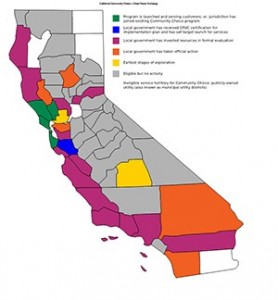
Source: Clean Power Exchange
In California, CCAs were enacted into law in 2002 and in the aftermath of the “failed deregulation” of the electric utility industry and with the passage of AB 117 championed by Paul Fenn and his company Local Clean Power. PG&E then spent $46 million on Proposition 16 to make it more difficult to form CCAs, requiring a two-thirds vote rather than a simple majority. The proposition was defeated by a $100,000 campaign coordinated by Local Power, which by then had assembled support from San Francisco, Los Angeles, Oakland, Berkeley, Marin County, and others.
Marin Clean Energy formed in 2010 offering 50 and 100% clean energy to its residents and businesses. Today, MCE services 175,000 customers in Marin, Napa County, and the cities of Benicia, El Cerrito, San Pablo, and Richmond. It is considered California’s first CCA program.
Big MCE news: MCE now is offering a renewable energy service that is 100% local, called Local Sol. Its power is 100% locally sourced clean energy. Local Sol customers directly fund a local solar project, ensuring that ratepayer dollars foster sustainable energy development in the community.
To serve the premium service, MCE recently unveiled a 1 MW, solar project at a quarry in Novato to provide the Local Sol service to 300 homes. This marks the completion of MCE’s fourth local feed-in tariff project. Local Sol customers get a guaranteed, long-term rate that’s currently about 30% more than MCE’s Deep Green rate (100% renewable energy). The cost of Local Sol is tied to the rates paid through MCE’s Feed-In Tariff program: 14.2¢ per kWh (13.8 ¢ + 0.4¢ for administrative costs).
Marin Clean Energy inspired Sonoma Clean Power (SCP) that was launched in 2014 offering power that is greener and locally sourced, at less costs than PG&E. SCP is made up of the County plus all eight eligible cities. Mendocino County elected to join SCP in 2016.
The first Southern California city to embrace CCA was Lancaster. The City formed Lancaster Choice Energy in 2015, beginning with municipal accounts. So far the city has enrolled 55,000 accounts and has provided 71% renewable power. Its goal is to be nation’s first net zero city. Recently, the CCA built its own 10 MW solar plant.
San Francisco has long been a leading California CCA proponent. Its Board of Supervisors and the voters approved a $1.2 billion “H Bond” issuance in 2004 for solar systems. Then in 2016, CleanPowerSF launched for residents and businesses. In 2004, the goal was to provide 51% renewable power to San Francisco. Now its goal is to provide citizens with 100% renewable power with no nuclear contribution.
Today, CleanPowerSF offers two options: “Green” which is 40% renewable (vs. PG&E at 29.5%) and “Super Green” which is 100% renewable. Super Green is priced at two cents more per kWh, and is promoted as a great way to support the City’s Climate Action Plan. CleanPowerSF is operated by the San Francisco PUC, the same agency that has been providing the City with Hetch Hetchy hydroelectricity for nearly 100 years. Most recently, and 48 miles to the south, San Jose enacted a CCA in May 2017.
Los Angeles Forms LACCE
 The big CCA news is California… is “CCE” news! In April, the LA County Commissioners approved the formation of LACCE, Los Angeles Clean Choice Energy. Now county facilities, unincorporated areas, and cities within LA County will be able to access clean, renewable power, cheaper and faster than if they stayed with Southern California Edison.
The big CCA news is California… is “CCE” news! In April, the LA County Commissioners approved the formation of LACCE, Los Angeles Clean Choice Energy. Now county facilities, unincorporated areas, and cities within LA County will be able to access clean, renewable power, cheaper and faster than if they stayed with Southern California Edison.
Experiences with CCAs in California have been positive. In Marin, Sonoma, San Francisco, and Lancaster, there has been success. These CCAs have been able to procure more renewables at low costs and have been able to pass on savings to their customers.
The CCA feasibility study for the LACCE found average potential savings of 10 – 15% on the generation across all rate classes. Assuming generation cost at half the total bill, that’s potential savings of 5 – 7.5%. And “That’s big money,” noted Gary Gero, the County’s CSO and lead on introducing the CCA opportunity to Los Angeles County’s 88 cities.
LA cities will pass resolutions to join LACCE. It’s anticipated that from the onset, a quarter of SCE’s load will be served by LACCE. LACCE will buy the renewable power, Edison will transmit and distribute it, and Edison will continue to send customers bills… including the CCA fee.
The Hawaiian Power Update
Hawaii’s largest utility, the Hawaiian Electric Company, generated 26% of the electricity its customers used from renewable sources in 2016. Consequently, Hawaiian Electric reduced its oil usage by 10.7 million barrels from 2008 to 2016, a 21% decrease. The State of Hawaii has a mandate for utilities to reach 100% renewable energy by 2045. Hawaiian Electric says it expects to reach that goal five years early.
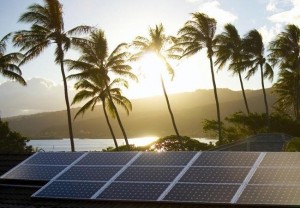 Of the 26% renewable power resources, more than a third of the electricity came from rooftop solar panels. Solar was followed closely by wind energy that provided 29% of the renewable energy. Biomass contributed 19% and 11% came from geothermal energy.
Of the 26% renewable power resources, more than a third of the electricity came from rooftop solar panels. Solar was followed closely by wind energy that provided 29% of the renewable energy. Biomass contributed 19% and 11% came from geothermal energy.
On Hawaii Island, which has the State’s only geothermal energy plant, more than half of the energy used came from renewable resources. Maui reached 37% renewables. On Oahu, where demand is greatest, 19% of the electricity came from renewables.
The rooftop solar industry slowed over the past year after the Public Utilities Commission in late 2015 ended net energy metering which credited customers for excess electricity generated at any given time. A replacement program called “customer grid supply” reimbursed customers for excess energy at a lower rate, but it too reached a cap on the eligible number of customers. The Commission recently decided to re-open the customer grid supply program for about 2,800 more private rooftop solar systems, half on Oahu.
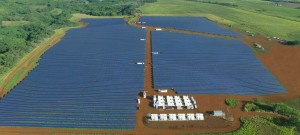 Also on the islands, Tesla is framing up a demonstration project on Kauai with thousands of solar panels and giant battery packs. In partnership with the Kauai Island Utility Cooperative (KIUC) the project will store the sun’s energy during the day and release it at night. The solar farm comprises 54,978 solar panels, which have 13 MW of capacity as well as 272, 52-MWh Tesla Powerpack lithium-ion battery storage systems. Using stored energy from Tesla’s power packs is expected to save KIUC 1.6 million gallons of diesel fuel annually.
Also on the islands, Tesla is framing up a demonstration project on Kauai with thousands of solar panels and giant battery packs. In partnership with the Kauai Island Utility Cooperative (KIUC) the project will store the sun’s energy during the day and release it at night. The solar farm comprises 54,978 solar panels, which have 13 MW of capacity as well as 272, 52-MWh Tesla Powerpack lithium-ion battery storage systems. Using stored energy from Tesla’s power packs is expected to save KIUC 1.6 million gallons of diesel fuel annually.
The Fortune 500 Nears the Tipping Point
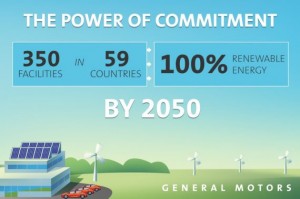 A report by World Wildlife Foundation, Ceres, Calvert Research & Management, and CDP (formerly the Carbon Disclosure Project) shows that nearly half of all Fortune 500 companies are setting renewable energy targets. The analysis finds that 48% of Fortune 500 companies now have targets in place for renewable energy procurement, carbon pollution reductions, and/or energy efficiency.
A report by World Wildlife Foundation, Ceres, Calvert Research & Management, and CDP (formerly the Carbon Disclosure Project) shows that nearly half of all Fortune 500 companies are setting renewable energy targets. The analysis finds that 48% of Fortune 500 companies now have targets in place for renewable energy procurement, carbon pollution reductions, and/or energy efficiency.
Fortune 500 companies like General Motors, Facebook, The Home Depot, and now Apple are investing in renewables. The report documents 53 Fortune 500 companies that have set renewable energy procurement goals; 23 of those companies have set 100% renewable energy targets. The majority of the 100% club set this goal in the past three years.
Many companies have relied on purchases of wind to move toward their targets. More than 6,700 MW of wind has been procured by corporate and non-utility purchasers. According to wind energy sources, “With costs falling by two-thirds over the past seven years and more than 18,700 MW of wind power capacity coming online in the near term, wind power stands ready to meet growing corporate demand.”
Kentucky Coal Museum
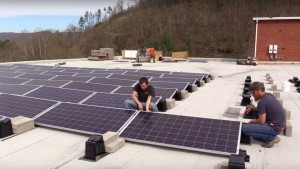 Sammy Roth of The Desert Sun brought this one to our attention. So did Thomas Friedman in a scathing view on the President’s touted coal revival. At the Kentucky Coal Mining Museum in Benham, Kentucky, at the Southeast Kentucky Community and Technical College, where visitors peruse mining memorabilia and the commonwealth’s coal camps, there’s some new action on the roof: 80 kW of photovoltaic panels.
Sammy Roth of The Desert Sun brought this one to our attention. So did Thomas Friedman in a scathing view on the President’s touted coal revival. At the Kentucky Coal Mining Museum in Benham, Kentucky, at the Southeast Kentucky Community and Technical College, where visitors peruse mining memorabilia and the commonwealth’s coal camps, there’s some new action on the roof: 80 kW of photovoltaic panels.
“This might be coal country,” said the head of Bluegrass Solar that installed the system, “but putting solar panels on top of the coal museum makes sense economically.” Friedman wrote that the installation was based on “solid economic reasons.” Bluegrass Solar focused on the museum’s need to trim expensive electric bills. Its president noted that the people in eastern Kentucky are becoming more interested in alternative energy options.
Nuclear Power Quiz: Six Questions
 Question #1: In what year did the most recent U.S. nuclear reactor come on line?
Question #1: In what year did the most recent U.S. nuclear reactor come on line?
Question #2: How many reactors are there operating in the United States?
Question #3: What’s the average age of the U.S. nuclear plants?
Question #4: How long can nuclear reactors operate?
Question #5: In what two decades were most American nuclear plants built?
Question #6: How much nuclear capacity is there in the U.S.?
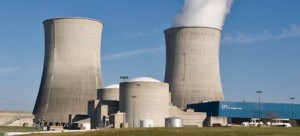
Watts Bar Nuclear Plant
Answer #1: The first new reactor to enter service in 20 years, since 1996, did so in 2016, the Watts Bar 2 reactor in Tennessee. The 1.15 GW plant cost ~$6.1 billion. And there four more are under construction.
Answer #2: There are 99 operating nuclear reactors at 61 plants across the country.
Answer #3: The capacity-weighted average age of U.S. nuclear plants is 37 years.
Answer #4: U.S. nuclear plants were licensed for an initial operating life of 40 years by the Nuclear Regulatory Commission (NRC). Owners of nuclear power plants can apply for a 20-year renewal. As of 2016, the NRC had granted license renewals to 84 of the 99 operating reactors in the United States.
Answer #5: Fully 95% of the nuclear capacity came online between 1970 and 1990. Costs, schedules, and public acceptance were all influenced by the accident at the Three Mile Island plant in 1979. From 1979 through 1988, 67 plants were canceled.
Answer #6: There is 99 GW of installed capacity in the U.S. That’s about 9% of national generating capacity. But since nuclear plants operate at high capacity factors, they contributed nearly 20% of total U.S. electricity generation in 2016.
In other nuclear news, there’s the sorry tale of nuclear needing yet another under-push. In New York and Illinois, ratepayers may be on the hook for up to $10 billion to subsidize the operation of nuclear plants. Experts claim that these are lifelines that need to be thrown to a struggling industry to maintain the “carbon-free electricity capacity” critical to reducing greenhouse gas emissions and fulfilling climate commitments. The slump in natural gas prices has hurt the profits of nuclear generators. Other states are considering similar price supports for nuclear for the same reason: In Connecticut, Dominion Resources Inc.’s 2.1-GW Millstone nuclear plant produces 98% of the state’s low-carbon power. In New Jersey, reactors produce 97%.
As gas prices are low, gas power plants are favored in each power system’s economic dispatch. New York nuclear plant operator, Exelon, has testified that its capacity is not valued highly enough and that without financial support it would have to shut down its Ginna and Nine Mile Point nuclear plants. Entergy, which operates the Fitzpatrick plant, said the same. Without those plants, New York would rely more on gas and coal, increasing GHG emissions.
Despite lifelines to keep reactors competitive and thus operational, nuclear power is declining in the United States. Retirements are outpacing new plants coming on line. Five reactors have closed since 2013. Several other plants have announced plans to retire soon including Oyster Creek, Pilgrim, Palisades 1, and Indian Point 2 and 3. Pacific Gas & Electric will not seek extensions for Diablo Canyon 1 and 2 when their licenses expire in 2024 and 2025.
Westinghouse’s Nuclear Bankruptcy
 Westinghouse Electric Company, a subsidiary of Toshiba, filed for Chapter 11 bankruptcy on March 29, 2017, reportedly “dragged down by huge losses” in its nuclear power plant construction business. It’s been one of the very big names in nuclear.
Westinghouse Electric Company, a subsidiary of Toshiba, filed for Chapter 11 bankruptcy on March 29, 2017, reportedly “dragged down by huge losses” in its nuclear power plant construction business. It’s been one of the very big names in nuclear.
George Westinghouse founded the Westinghouse Electric Corporation in 1886. He teamed up with Nikola Tesla to develop and promote AC power, instead of the DC power infrastructure preferred by Thomas Edison. To this day the world’s electrical system is still almost exclusively based on AC power.
Over a 100-year period the Westinghouse Electric Corporation expanded into appliances, locomotives, entertainment – and even solar power. For years, Westinghouse held the record for solar cell efficiency. Then in the 1990s Westinghouse Electric Corporation concluded that its broadcasting subsidiary – the Columbia Broadcasting System (CBS) – had the potential to be more profitable than its manufacturing businesses. So Westinghouse sold off all of its manufacturing operations, renamed the parent company as CBS, and licensed the Westinghouse name to leading companies in related market segments.
During this divestiture, Westinghouse’s nuclear business, which was named the Westinghouse Electric Company, ended up as a subsidiary of Toshiba. Toshiba expected to benefit from a renaissance in nuclear power, leveraging less expensive reactor designs and the need for carbon-free electricity. But the actual construction ended up being expensive and time consuming. And nuclear power is still plagued by safety, nuclear waste and proliferation issues. “And the final nail in the nuclear coffin is economic: electric power plants fueled by natural gas, solar and wind are much less expensive to build and operate.”
Meatless and Healthy Mondays
 Meatless Monday is an international campaign that encourages people to not eat meat on Mondays to improve their health and the health of the planet. Meatless Monday is a non-profit initiative of The Monday Campaigns Inc. in association with the Johns Hopkins Bloomberg School of Public Health Center for a Livable Future. Meatless Monday was founded in 2003 by marketing professional Sid Lerner. The program follows the nutrition guidelines developed by the USDA.
Meatless Monday is an international campaign that encourages people to not eat meat on Mondays to improve their health and the health of the planet. Meatless Monday is a non-profit initiative of The Monday Campaigns Inc. in association with the Johns Hopkins Bloomberg School of Public Health Center for a Livable Future. Meatless Monday was founded in 2003 by marketing professional Sid Lerner. The program follows the nutrition guidelines developed by the USDA.
Meatless Monday is part of the Healthy Monday initiative. Other Healthy Monday campaigns include: The Kids Cook Monday, Monday 2000, Quit and Stay Quit Monday, Move it Monday, The Monday Mile, and others.
Meatless Monday focuses its initiative on Mondays for several reasons. Monday is typically the beginning of the work week, the day when individuals settle back into their weekly routine. Habits that prevailed over the weekend can be forgotten and replaced by other choices. And a weekly reminder to restart healthy habits also encourages success. A 2009 trial published in the American Journal of Preventative Medicine provided individuals with weekly health prompts and encouragement. Approximately two thirds of participants responded with improvements in their overall health, eating habits and physical activity levels.
Solar Power in the Middle East
Try this twist: a solar-powered gas station in Dubai. Really? The United Arab Emirates is the fourth-largest oil producer in the world. Yes, the Emirates National Oil Company has opened the first solar-powered gas station. There, 120 kW of solar will provide 130% of the station’s operating needs, the excess is reportedly fed back into the grid.
It’s part of a larger movement, the transition away from fossil fuels. The UAE fears sea level rise. Much of its land would be threatened by sea level rise. So the government is supporting renewable energy. Solar farms are “springing up everywhere” to take advantage of the country’s consistent and abundant sunshine.
In recognition of the country’s commitment to sustainable energy, the International Renewable Energy Agency has chosen Abu Dhabi, the UAE’s other major city, as the home for its global headquarters. And in related news, Dubai’s Roads and Transport Authority has agreed to lease 200 Tesla electric cars for use as taxis in Dubai.
The Saudi Vision 2030 marks a profound decree: In April 2016, Deputy Crown Prince Mohammad bin Salman Al Saud, announced the Saudi Vision 2030. One of its goals: Freedom from Oil. The powerful Deputy Crown Prince pushing to undertake a transformation of the Saudi economy. Saudi Vision 2030 is a plan to reduce Saudi Arabia’s dependence on oil and to increase alternatives, forming a diverse economy through the development of service sectors such as health, education, infrastructure constructive, recreation and tourism.
The Plan calls for developing a “vast pool of solar energy” in the north of the country. Saudi Arabia’s energy minister, Khalid Al-Falih, said that his country will solicit bids for a “massive renewable energy push,” with spending to be ramped up to as high as $50 billion. The move is intended to source at least 9.5 GW of electricity from solar and wind by 2023 and to achieve the goal of generating 30% of the Kingdom’s electricity from renewable and nuclear sources by 2030.
There are two key objectives that a build out of renewable energy would achieve: leave more oil for export, thus generating more government revenue, while at the same time diversifying the economy. As part of the Vision 2030 plan, the government plans on spinning off a small slice of Saudi Aramco. Experts believe that an IPO of 5% of the company could generate more than $100 billion in revenue, which the prince plans on putting to good use developing other sectors of the economy.
Bloomberg cautions that the Saudi government has been “talking a big game” on renewable energy for several years. In 2012, the government laid out a proposal to install 41 GW of solar by 2032, photovoltaics and concentrated solar power. The ramp up was to begin immediately. The collapse of oil prices in 2014 dashed all urgency. To date, the country has only a single, 10 MW project at the headquarters of Saudi Aramco.
Microgrids and PERCs White Paper

Source: Stone Edge Farm
Microgrids are one of the hottest topics and opportunities in the power sector. Taking advantage of advances in energy storage technology and sophisticated controls, there is a remarkable explosion of interest in creating microgrids… smaller and smarter power grids; not replacing but augmenting centralized utility systems. Small is beautiful! Microgrids are elegant, sustainable, resilient, and can be both carbon-free and cost-effective.
Microgrids are not a new construct. Thomas Edison began with a microgrid. They’ve been on college campuses and at medical centers for years, often based on combined heat and power systems. EcoMotion’s new white paper introduces a new and exciting forms of microgrid. The paper hones in on microgrids that combine renewable energy with energy storage and energy efficiency. They may become ubiquitous throughout North America given their consumer and community values. They are a new form of microgrid, carbon-free microgrids.
Advanced, carbon-free microgrids utilize their assets in many ways. Daily, they can buy power at night when rates are low, store it in their batteries, and discharge during peak periods, avoiding peak rates. They can be used to trim costly spikes in demand. As EcoMotion proves, they can be financed, and used for short and long-term power outages. Beyond that they can sell excess storage capacity to utility demand response programs and in the future, for ISO ancillary services.
This new form of microgrids works daily and then really springs into action when the big grid goes down. For prolonged outages, they become PERCs, Powered Emergency Response Centers, providing huge community benefit for first responders, for communications systems, and emergency EV charging. By ramping down to “PERC-mode,” these school sites become islands of limited but critical power indefinitely.
 For a copy of EcoMotion’s recent white paper – Crafting and Financing Carbon-Free Microgrids – click here!
For a copy of EcoMotion’s recent white paper – Crafting and Financing Carbon-Free Microgrids – click here!
For a great read one man’s mission to promote solar and storage and energy independence, check out Vince Battaglia’s book, Cut the Cord: How to Achieve Energy Independence by Joining the Solar-Powered Microgrid Revolution. Vince is a longstanding EcoMotion colleague and friend, founder and CEO of Palm Desert’s Renova Solar. In the book, Vince weaves together his life, passions, while building a strong case for “microgrids.”
